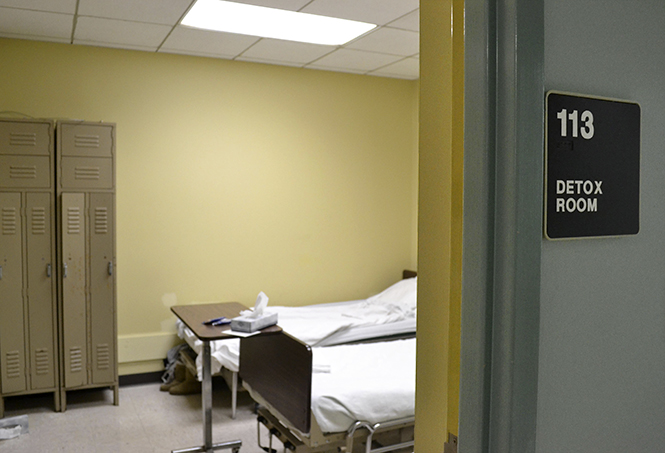Lack of space, availability among roadblocks for Portage County heroin addicts
March 7, 2013
Oriana House facts and figures
Total number of admissions into detox at Oriana House:
2008 – 1,509
2009 – 1,500
2010 – 1,467
2011 – 1,492
2012 – 1,534
Number of detox admissions for opiate addiction:
2008 – 744 (49.3% of total)
2009 – 785 (52.3% of total)
2010 – 558 (38% of total)
2011 – 890 (59.7% of total)
2012 – 1,025 (66.8% of total)
Total heroin admissions aged 12 and older in 2011: 9,379
Information courtesy of the 2011 report on substance abuse treatment by the Substance Abuse and Mental Health Services Administration.
Heroin addicts seeking treatment in Portage County may experience more than withdrawal from the drug as an obstacle to their recovery.
With no detoxification facility in the county, uninsured addicts must attend one of two facilities in Akron or Canton. These two facilities only have a combined 25 beds to serve not only their county’s needs, but other counties as well.
Detox involves 24-hour care where the heroin addict can safely go through the process of withdrawal. The process is just the beginning of an addict’s recovery. Behavioral counseling follows the detox, which addresses core issues on why the addict started using and transitioning them to a healthier lifestyle.
Approximately four people died each day in Ohio from drug overdose in 2010, according to an Ohio Department of Health report. The report measures the patterns, causes and effects of injury over time.
The trend coincides with an increase of heroin overdose deaths in Portage County, a rise from one death in 2011 to seven confirmed in 2012. While an all-male inpatient treatment facility is set to open in the county sometime in March, a detox facility is currently out of reach.
Heroin addicts from Portage County who seek recovery treatment through detox must contact Townhall II, an outpatient facility in downtown Kent that provides services for substance abuse.
If he or she is approved for detox treatment, Townhall II will call the two facilities that uninsured Portage County citizens can use: Oriana House Inc. in Akron and the Canton Crisis Intervention and Recovery Center.
Addicts who are insured and seeking services can attend a private facility outside the county, go through Townhall II or go to St. Thomas Hospital, which has a small detox unit.
Clients then receive treatment through the funding of the Mental Health and Recovery Board of Portage County.
Detox treatment for the two facilities ranges from $305-370 a night, with the stay usually lasting close to five days. The Board pays for one round of detox treatment for each client a year with mandatory counseling following the process.
But when it came to needing an inpatient facility to build on his detox, Taugner had nowhere to turn.
He moved to downtown Cleveland in April 2010, and stayed at 2100 Lakeside Men’s Homeless Shelter for three days. Once he established residency as a Cuyahoga County citizen, he was able to seek treatment at Stella Maris recovery center. There he went through a 12-step program and cognitive behavioral therapy.
Today, as a co-founder of Portage County’s Citizens for Addiction Recovery and Education, Inc., Taugner is working to help make recovery for heroin addicts a more simple process with a campaign to open a male inpatient recovery center in Portage County.
“Having to do that and not having any resources in Portage County is frustrating,” Taugner said. “There are so many people that need help. I wanted help and did what I had to do to get help. I don’t want people to go through the same crap I had to go through with the homeless shelter and everything.”
Taugner’s goal has almost been reached, as a male inpatient facility for counseling addiction services is set to open sometime in March at a yet-to-be disclosed location. Funding for the facility will come through the Mental Health & Recovery Board of Portage County, but it is only the beginning, as a detox facility is not within reach.
Without a facility in the area, Taugner has received numerous calls from concerned family and friends of addicts; seeking answers to the always-frustrating question “Where to get an addict treatment?” It took Taugner living in a homeless shelter in Cleveland and leaving his life behind to seek help.
“It’s frustrating not having that for them,” Taugner said. “Even when I was getting high, I was complaining about there being nowhere to go. I wanted to stop, but I had no idea what to do.”
According to the Substance Abuse and Mental Health Administration, of the 9,379 addicts entering treatment for heroin in Ohio in 2010, over 50 percent of patients ranged from the ages of 20-29.
The increasing prevalence of heroin and the demographic it is destroying is troubling for Richardson and the staff at Oriana House.
“Heroin is a definite constant,” Richardson. “The opiate epidemic, when you talk about prescription drugs, it’s rampant. That’s why there is such an urgency to combat the epidemic. It falls right into the age trend of the college student and that’s what we see.”
Contact Lance Lysowski at [email protected].













